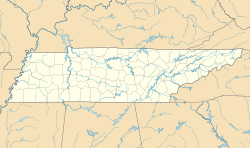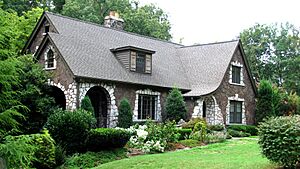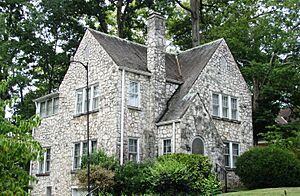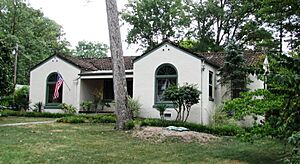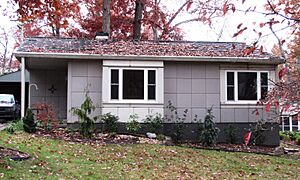Lindbergh Forest facts for kids
Quick facts for kids |
|
|
Lindbergh Forest Historic District
|
|
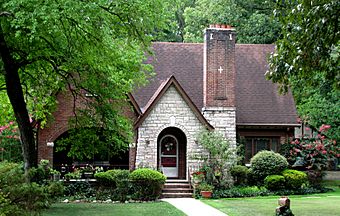
Tudor Revival-style house at 3419 Southwood Drive, built c. 1929
|
|
| Location | Along Chamberlain, Druid, Glenhurst, Southwood, Winslow, and Woodlawn Knoxville, Tennessee |
|---|---|
| Area | approximately 25 acres (10 ha) |
| Built | 1929–1947 |
| Architectural style | Tudor Revival, Colonial Revival, Spanish Revival, Lustron |
| NRHP reference No. | 94001261 |
| Added to NRHP | February 10, 1998 |
Lindbergh Forest is a neighborhood in Knoxville, Tennessee, United States. It is located off Chapman Highway (US-441) in South Knoxville. This area is special because it is listed on the National Register of Historic Places as an historic district.
The neighborhood started in the late 1920s. It was one of Knoxville's first suburbs designed for people who drove cars. Today, it is known for its homes built in the late 1920s and early 1930s. Many of these homes feature details made from East Tennessee marble. Lindbergh Forest also has two of Knoxville's five remaining Lustron houses. These are special pre-made homes. In 1998, many of its houses were added to the National Register of Historic Places. This created the Lindbergh Forest Historic District.
Contents
Exploring Lindbergh Forest's Location
Lindbergh Forest used to be a smaller area. It was bordered by Chapman Highway, Woodlawn Pike, and Moody Avenue. Today, the neighborhood has grown. It now covers almost one square mile.
The current borders, set in 2015, are Chapman Highway to the west, East Moody Avenue to the east, and Lippencott Street and Davenport Road to the north. The neighborhood includes about 200 single-family homes. It also has four apartment buildings and Dogwood Elementary School. You can find the Sarah Simpson Professional Development Technology Center here too. There are about 18 different businesses, Graystone Presbyterian Church, and the Cecil Webb Recreation Center. A walking trail behind Dogwood Elementary School connects Lindbergh Forest to Knoxville's Urban Wilderness.
Lindbergh Forest is a very green neighborhood. It has many old, tall trees. The streets follow the natural shape of the land. This makes it a quiet and peaceful place. It is a big change from the busy areas along Chapman Highway nearby.
The Story of Lindbergh Forest
In the late 1920s, a real estate developer named Victor McClain bought the land that is now Lindbergh Forest. He bought it from Samuel B. Luttrell. Samuel was the son of a former Knoxville mayor, James C. Luttrell. McClain had become wealthy by building new neighborhoods in Florida. He wanted to create a neighborhood in Knoxville for people who drove cars to work. More and more people were using cars then.
Other "automobile suburbs" were being built in Knoxville at this time. Examples include North Hills and Sequoyah Hills. But building in South Knoxville was risky. There wasn't a good bridge for cars across the Tennessee River. The Henley Street Bridge was finished in 1931. This solved the problem, and the first land lots sold very well.
To help promote the new neighborhood, McClain offered $100. This money would go to the person who came up with the best name. The winning name was "Lindbergh Forest." It was suggested by Emilee Cate. She chose the name to honor the famous pilot Charles Lindbergh. He had just completed his amazing flight across the Atlantic Ocean in 1927. Emilee Cate was the wife of Sheriff J. Carroll Cate. The Cates lived on Chamberlain Boulevard.
Early residents of Lindbergh Forest included many different people. There were local business owners and local politicians. Professors from the University of Tennessee lived there. Employees of the Tennessee Valley Authority also made their homes in the neighborhood. During the 1930s, three mayors of Knoxville lived in Lindbergh Forest. They were John T. O'Connor, James Elmore, Sr., and Walter Mynatt.
Lindbergh Forest Historic District Homes
The Lindbergh Forest Historic District includes 38 important houses. It also has 10 important garages. All of these were built between 1929 and 1947. The streets and the special lamp posts are also part of the historic listing.
The most common style of architecture in the district is Tudor Revival. Other styles include Colonial Revival, Minimal Traditional, Bungalow, Spanish Eclectic, and Modern. The district is also home to two Lustron houses. These were special pre-made homes. They were designed by the Lustron Corporation to help with housing shortages after World War II.
The lamp posts in Lindbergh Forest are original from when the neighborhood was first built. These posts look like old colonial-era gas lights. They are about 8 feet (2.4 m) tall. They have decorative wrought iron tops.
Cool Houses in the District
- 214 Druid Drive: This is a one-story Tudor Revival-style house. It was built around 1930. The outside of the house is made of stone. It has window sills made of East Tennessee marble.
- 240 Druid Drive: This house is one and a half stories tall. It is in the Spanish Eclectic style and was built around 1929. The outside walls are made of rough limestone. It has East Tennessee marble trim.
- 244 Druid Drive: This is a two-story Tudor Revival-style house. It also has some Colonial influences. It was built around 1929. The outside is made of limestone blocks with brick trim.
- 222 Chamberlain Boulevard: This is a one-story Lustron house. It was built around 1947.
- 229 Chamberlain Boulevard: This is a two-story Eclectic house. It mixes Tudor Revival and Chateauesque styles. It was built around 1930. The outside of the house is made of East Tennessee marble.
- 254 Chamberlain Boulevard: This is a two-story Tudor Revival-style house. It has a limestone outside. It was built around 1929.
- 301 Chamberlain Boulevard: This is a one and a half-story Tudor Revival-style house. It has Chateauesque influences. It was built around 1929. The outside is made of rough limestone with East Tennessee marble trim.
- 306 Chamberlain Boulevard: This is a one-story Mission-style house. It has Spanish Colonial influences. It was built around 1929. The house has stucco walls and a terra cotta tile roof.
- 3419 Southwood Drive: This is a one-story Tudor Revival-style house. It was built around 1929. The outside is made of brick and limestone. It has an arched porch and a chimney with a cross pattern.
- 3514 Southwood Drive: This is a one and a half-story Tudor Revival-style house. It has some Minimal Traditional influences. The outside is made of rough East Tennessee marble.
- 327 Winslow Drive: This is a one-story Colonial Revival-style house. It was built around 1937. The outside is made of brick with East Tennessee marble trim.
- 3510 Glenhurst Drive: This is another one-story Lustron house. It was built around 1947.


